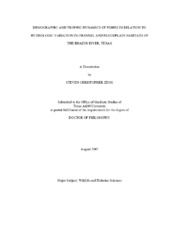| dc.contributor.advisor | Winemiller, Kirk | |
| dc.creator | Zeug, Steven Christopher | |
| dc.date.accessioned | 2010-01-15T00:16:13Z | |
| dc.date.accessioned | 2010-01-16T02:25:59Z | |
| dc.date.available | 2010-01-15T00:16:13Z | |
| dc.date.available | 2010-01-16T02:25:59Z | |
| dc.date.created | 2007-08 | |
| dc.date.issued | 2009-06-02 | |
| dc.identifier.uri | https://hdl.handle.net/1969.1/ETD-TAMU-1971 | |
| dc.description.abstract | Large rivers in North America have been subjected to a variety of hydrologic
alterations that have negatively impacted aquatic fauna. These impacts have triggered
restoration efforts, including management of flows, to restore or maintain ecological
integrity. Ecological data relevant to flow management and habitat restoration is scarce,
and conceptual models of ecosystem function have been widely applied to large rivers
despite a lack of quantitative evaluation of these models. Here, I examine demographic
and trophic dynamics of fishes with divergent life histories and trophic guilds in relation
to habitat heterogeneity and flow variability in a relatively unaltered floodplain system:
the Brazos River, Texas. Reproductive activity of fishes with three divergent life history
strategies was positively associated with long-term river hydrology, although species
with alternate strategies exploited different portions of the hydrograph (peak flow versus
increasing flow). Despite the positive association with hydrology, low-flow periods
were favorable for recruitment, and food resources for larvae and juveniles were denser
during these periods. Some species used both oxbow and channel habitats during some
point in their life cycle, whereas other species appeared to be almost entirely restricted to
one habitat type. Terrestrial C3 macrophytes accounted for a significant fraction of the biomass of
most consumer species examined. Small-bodied species in oxbow lakes assimilated
large fractions of biomass from benthic algae, whereas this pattern was not observed in
the river channel. Frequent flow variations in the river channel may reduce algal
standing stocks, and significant contributions from autochthonous algal sources may
only occur during low-flow periods. Trophic positions of detritivores indicated that
terrestrial carbon sources were assimilated, for the most part, via invertebrates rather
than by direct consumption. My results indicate that current conceptual models are too
vague to provide accurate predictions for restoration strategies in rivers with variable
flow regimes. Flow and habitat management strategies that focus on reproducing key
features of historical fluvial dynamics are likely to be more successful than strategies
that focus on single indicator species or flow dynamics that differ from the historical
hydrograph. | en |
| dc.format.medium | electronic | en |
| dc.format.mimetype | application/pdf | |
| dc.language.iso | en_US | |
| dc.subject | reproduction | en |
| dc.subject | recruitment | en |
| dc.subject | isotopes | en |
| dc.subject | food web | en |
| dc.title | Demographic and trophic dynamics of fishes in relation to hydrologic variation in channel and floodplain habitats of the Brazos River, Texas. | en |
| dc.type | Book | en |
| dc.type | Thesis | en |
| thesis.degree.department | Wildlife and Fisheries Sciences | en |
| thesis.degree.discipline | Wildlife and Fisheries Sciences | en |
| thesis.degree.grantor | Texas A&M University | en |
| thesis.degree.name | Doctor of Philosophy | en |
| thesis.degree.level | Doctoral | en |
| dc.contributor.committeeMember | Briske, David | |
| dc.contributor.committeeMember | Davis, Stephen | |
| dc.contributor.committeeMember | Fitzgerald, Lee | |
| dc.type.genre | Electronic Dissertation | en |
| dc.type.material | text | en |
| dc.format.digitalOrigin | born digital | en |


